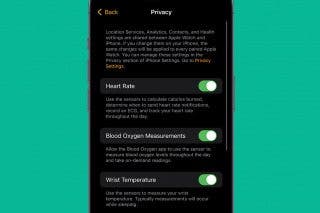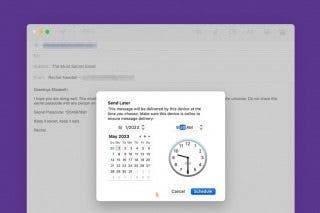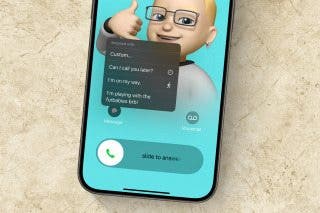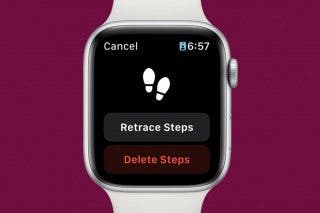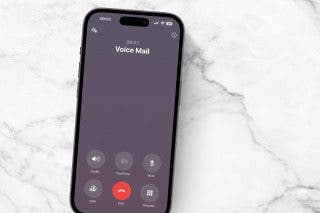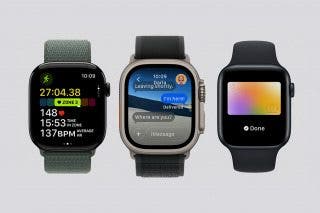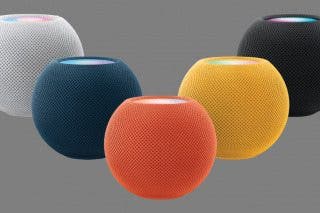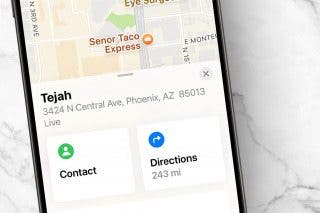How I Built iPhone Life Part 2


In the 117th episode, iPhone Life’s founder Hal Goldstein returns to the show to share how the invention of the iPhone changed everything for his tech publishing company and how he managed to adapt with the times.
Click here to listen and subscribe. If you like what you hear, be sure to leave a review. And remember to tune in every other week to hear our editors share with you the latest Apple news, best apps, iPhone tricks, and coolest accessories.
This episode is brought to you by Fanatic, the makers of Informant 5. Let's face it: Apple's Calendar app is basically a to-do list. You need an app with the power to tackle your busy day. Informant 5 is the best calendar app and task manager you’ll find to help you manage both your work and personal life. Manage projects with tasks and notes, sync your calendar among all your devices, get a user-friendly 30-day calendar view, and much more. Get Informant 5 for your iPhone and iPad today.
Special Discount for Podcast Listeners!
Want more iOS how-to content that's designed to make your life easier and more productive? Visit iPhoneLife.com/PodcastDiscount and get $5 off our premium subscription to iPhone Life Insider.
Question of the week:
Who would win in a fight between a pirate and a ninja? Bonus if you remember which one the majority of the iPhone Life staff favors. Email your answer to podcasts@iphonelife.com.
Articles referred to in this episode:
Book referred to in this episode:
Useful links:
- Join the iPhone Life Facebook Group
- Insider walk-through: get a sneak peek of members-only benefits
- Get the Insider discount for Podcast Listeners
- Sign up for the free Tip of the Day Newsletter
- Email the Podcast
- Archive of Show Notes for iPhone Life Podcast
- Subscribe to iPhone Life magazine
Transcript of episode 117:
Donna Cleveland: Hi, and welcome to The iPhone Life Podcast. I'm Donna Cleveland, Editor in Chief at iPhone Life.
David Averbach: I'm David Averbach, CEO and Publisher.
Donna Cleveland: And we have a special guest today, Hal Goldstein is returning to the podcast. He's the founder of iPhone Life and author of the Meditating Entrepreneurs: Creating Success from the Stillness Within. If you listened to the last episode, you will know that we've been doing a two-part series where we're covering the history of iPhone Life and doing a sort of how I built this style podcast about everything that the personalities and the kind of triumphs and tribulations of running this company. So if you didn't listen to the last episode, I recommend that you go back one and catch up because we start with how Hal moved to Fairfield, Iowa, and started a tech focused publishing company out in the middle of nowhere. And it's a really fun story to hear.
Donna Cleveland: Today, we're going to be jumping into how the company changed when Steve Jobs came out with the iPhone, how a company that used to focus on other tech began focusing on Apple devices. So that's where we'll be focusing today. But first we want to tell you about our sponsor.
David Averbach: So our sponsor today is Fanatic, and they Informant 5, which is a calendar app, and we like to call it the calendar app Apple should have made. Because, first of all, so much more feature rich than the Apple's calendar app, so much more easier to use, and one of the things they do that I love is they combine reminders and calendar into one thing. So when you're trying to figure out, so many people either use reminders, or they use calendar, because there's enough of an overlap where it can be hard to figure out what to use and when. So combining them into one app, especially because sometimes you want to have layers, right, you want to have a meeting, but then you want to have reminders to go over in that meeting. Things like that they do so well.
David Averbach: It's free to download, they have a paid version. It works across all of your devices. So on your Mac, on your iPad, on your iPhone, on PC. So make sure you check it out, it's called Informant 5 by Fanatic. It's in the App Store, we'll link to it though at iPhonelife.com/podcast.
Hal Goldstein: You know, they won our award year after year in the 2000s.
David Averbach: Really?
Hal Goldstein: Yes.
Donna Cleveland: Really.
Hal Goldstein: As best calendar app, or I forgot what category it was. But they were great.
David Averbach: Yeah.
Hal Goldstein: [crosstalk 00:02:32] around, they've been doing this for a long time.
David Averbach: Absolutely. And one of the things I love about them too is exactly that, that they're very passionate about this. Whenever I'm talking to him, he's always rolling out some new feature to make it easier to schedule something. I mean, little details, and they put so much passion into it.
Hal Goldstein: Yes.
Donna Cleveland: So, if you have not signed up for the daily tips newsletter, I want to tell you about that quickly. Our daily tips newsletter is an awesome way to learn how to get the most out of your device in just one minute each day. If you go to iPhonelife.com/dailytips, you can sign up. Today's daily tip is how to add a widget to your Today View, and also just what is a widget. Because some people aren't sure what that is.
Donna Cleveland: First of all, what is a widget. If you've used Android devices, then you've known this probably for a long time. It's little bits of information that you can access from your home screen such as the weather, your calendar, just useful views for you. For a long time, the iPhone didn't have widgets. In my opinion, I'm still not that happy with Apple's widgets, I would love to be able to customize and add ones to my home screen how I like. But Apple does have a widget view now in the Today View, which you access by swiping home from the lock screen or from the home screen of your device. There you'll see a list of little, for instance, Apple's weather app.
David Averbach: Sorry, swiping to the left. When you're on your home screen, you swipe to the left.
Donna Cleveland: But you swipe to the right.
David Averbach: Swipe to the ... okay, you swipe to the right, it's located on the left. You said swipe home, which got confusing.
Donna Cleveland: Okay.
David Averbach: Okay. Hopefully that really cleared it up.
Donna Cleveland: Okay. So if you're on your home screen, you swipe from left to right.
David Averbach: There you go.
Donna Cleveland: And it will be located to the left of your home screen. [crosstalk 00:04:23].
David Averbach: That's what I'm trying to convey.
Donna Cleveland: Okay. Once you're there. You can customize what widgets show up by scrolling all the way down to the bottom of your Today View. And you'll see a little button that says edit, you'll tap that, and from there you'll see a list of all of the widgets that by default Apple put there, and you can either remove all of those, or keep those and add new ones to it. Like all of your third-party apps that have widgets available will show up there. For instance, I use a third-party weather app called Dark Sky, so I can add that widget and have it be at the top for me to view. Also, I recommend adding the battery widget, because that will show you the battery levels of other Apple devices, especially if you have AirPods, it's really nice.
David Averbach: Yeah. It's a good tip for a couple of reasons, first of all, because I always forget widgets exist, and they are useful, they're just kind of hidden. So it's a good reminder, even if you knew about it, to go do it. Second of all, they're really unintuitive to set up. I always think it should be in settings, but it's not. You have to go to the widgets area, and scroll down to the bottom. Do you use widgets at all, Hal?
Hal Goldstein: No, and it's funny, I mean to. But when you first started talking, I was actually a little bit confused with, what do you call, the control screen?
David Averbach: Yeah, yeah, yeah, yeah.
Hal Goldstein: Yeah. That you swipe down, but those are really Apple widgets really. We shouldn't use that, we're in widgets. But they do similar kinds of things, right.
David Averbach: Yeah. They're almost like shortcuts, whereas widgets are like conveying information at a glance.
Donna Cleveland: [crosstalk 00:05:49].
David Averbach: It's how I would describe the difference.
Hal Goldstein: Oh, that's a good way, thank you. That's a good way.
David Averbach: So you don't use them at all, huh?
Hal Goldstein: I remember doing it, at one point, I set them up, but I don't use them. It's been years since they first came out, I haven't used them.
David Averbach: Yeah. I mean, I didn't until we did the beginners class. And we went over how to set them up, and I started to set them up again. I, thanks to Donna's recommendation, have batteries there. I can't get my AirPods to show up under the batteries, is there something special you do to get them to show up?
Donna Cleveland: I think it's like having them within range is one thing I've noticed. Maybe opening the lid. I'm trying to remember now, because mine aren't showing up right now either. But I think it's within having them within range.
David Averbach: Gotcha.
Donna Cleveland: Bluetooth range.
David Averbach: Then, I like Weather Underground, what weather app do you guys use? I'm going off the rails here.
Hal Goldstein: WeatherBug, I think.
David Averbach: You use WeatherBug?
Hal Goldstein: Yeah.
Donna Cleveland: I use Apple's weather app and Dark Sky.
David Averbach: Okay. Dark Sky is one we talk about frequently on this podcast. What's nice about it, I use Weather Underground and Dark Sky. Dark Sky uses micro-locations, and AI to have what they call a better, a more accurate prediction of when it's going to rain. So what I find is if I use Weather Underground, it'll say, "There's a 20% chance of rain today." Or like, even if you go hour by hour, it's not that great. Whereas, Dark Sky can be like, "It's going to rain in the next 20 minutes." And it'll actually send me push notification about that. So that's what I use too is Weather Underground and Dark Sky, then I have the calendar.
Hal Goldstein: We need a weather app here.
David Averbach: Yeah.
Hal Goldstein: In the middle of Midwest.
David Averbach: Yeah, in Iowa. The weather changes frequently.
Donna Cleveland: I'd like to take a minute to tell you about iPhone Life Insider before we get into the story of iPhone Life. iPhone Life Insider is our premium subscription, it's a monthly subscription that gives you full educational content to how to use your device and really get the most out of your Apple devices, that you already have invested so much in, you really should get the most out of them, and make sure that you're enjoying all of the amazing features that Apple has to offer. So, if you go to iphonelife.com/podcastdiscount, you can get a $5 discount off of an annual subscription. And I'll tell you quickly about some of the features you'll get when you sign up.
Donna Cleveland: So you get a digital subscription to iPhone Life Magazine. We've been around for a long time now, so it's over 30 issues that you get access to. You get our video guides, which we have a full library, and we're coming out with the iOS 13 guide very soon. When Apple comes out with its newest version of operating system, you really want to learn all the new features as quickly as you can so you don't get confused. We make that really easy for you. We also offer Ask an Editor, a feature where you can send in your tech questions to us, and we'll help guide you to solutions. You get the premium version of this podcast without any ads, and also you get premium content just for Insiders. So, if you go to iPhonelife.com/podcastdiscount, you can sign up, and we highly recommend that you do.
Hal Goldstein: Absolutely.
Donna Cleveland: All right. Last episode we left off in the story of iPhone Life right around where you were about to close the doors. Hal, can you remind us where?
Hal Goldstein: Yeah. What had happened was that we've been supporting with the magazines, and actually apps and hardware, used equipment, we've been serving Microsoft Pocket PCs, and then, as the smartphone came into existence, Microsoft-based smartphones. The problem was that in 2007, Steve Jobs introduced the iPhone, and then in 2008, the economy collapsed. There was a period by the end of 2008 where nobody was buying Microsoft devices, which meant nobody was buying our magazine, nobody was buying it off our newsstand. Cash just went from up here to boom.
Hal Goldstein: Our printing bills, we were printing up a lot of issues that we'd sent to newsstands around the world. I mean, printing bills over $100,000 each. And I had a fairly big staff. And all of a sudden everything just dried up. It just went from light to dark in just months. So I kept laying people off, which I had never done, I'd actually had a policy where, sort of a no layoff policy, but I just, to survive we had to lay people off. Finally, we got down to just we couldn't make it work.
Donna Cleveland: Wow. This happened all within like how much time?
Hal Goldstein: Gradually over in six to nine month period. But the trend had been going. And we did notice. When we did the Smartphone & Pocket PC Magazine, we would put an iPhone on the cover every couple issues. Is the iPhone better?
David Averbach: Yeah, yeah, yeah, yeah.
Hal Goldstein: Yeah. Is this for real? Or something like that. Whenever we put the iPhone on the cover, the sales would spike. We tried it three times, and three times that happened. But it was pretty grim.
Donna Cleveland: And before that, had the company been doing really well? Like before the iPhone came out?
Hal Goldstein: It was doing okay. I mean, by 2006, that was sort of the height of the Pocket PC and smartphone, it was starting to go down a little bit. It was the beginning of what you guys have experienced, that people stopped buying magazines. You know, with the internet-
David Averbach: A lot of rough trends all happen at the same time.
Hal Goldstein: Yeah. Yeah. So the internet really made, in a lot of ways, for people who didn't like the physicality of a magazine, more obsolete. Things were not trending well. We were in the wrong platform, the wrong industry. We'd been around since 1985, and running your own business, especially when you don't know what you're doing, and obviously I had an intuition and a sense of where to go, but I didn't have very good systems. There was always a lot of ... Efficiency was never one of my strong suits.
Donna Cleveland: I love in your book, and just in general, how frank you are. Like you both talk about all the great things you did, but also don't shy away from areas that you were floundering.
David Averbach: I want to tell a funny story about Hal's efficiency. When I started here, and we'll get into that, nobody would know the day we went to print, it was this giant secret, because Hal would make up a day to try to get people to get ready to go to print, but he knew that he would not be able to resist making a ton of changes. So there would be like the fake print day, and then the real print day that no one knew, and it was this like, everyone was guessing about how much time Hal was giving them to buffer.
Hal Goldstein: I forgot about that.
Donna Cleveland: That's amazing. I feel that reminds me my mom always doing that to my dad, about like lunch plans and things like that to try-
David Averbach: Be there 11:30.
Donna Cleveland: Yeah.
Hal Goldstein: Yeah. That's where graphic artists [crosstalk 00:12:59].
David Averbach: I know.
Hal Goldstein: So, do we have a question here? So you want me to-
Donna Cleveland: Yeah.
Hal Goldstein: ... or should I just start talking here?
Donna Cleveland: Yeah. No. Let's get back into what happened then when you realized that you didn't really have a business anymore.
Hal Goldstein: I had a fellow, Rich Hall, who had been actually editing our magazines for 20 years. He started with me with the Portable Paper in the late '80s. Then, I had this other woman, her name was Marge Enright, and she was like a customer service person. She was so good at customer service and so friendly, that people, without an issue, used to call us. People would just call to talk to Marge, which would drive me nuts. I said to both of them, I said, "Listen, I have this idea. I think there's a way, but I've got to let you go, you'd have to work as a volunteer. And I think there's a chance we could might be able to pull this out. If we do, I'll make it good with you."
Hal Goldstein: We had a few other people that bought and sold used equipment. But in terms of our editorial staff, it became Richard, Marge and I, without any kind of income coming in.
Donna Cleveland: Wow. And you had the idea to start iPhone Life?
Hal Goldstein: Yeah. So here's the idea. The punchline is, I saw that every single issue that we have the iPhone on the cover, things just did really well. We had this huge newsstand distribution, and we had a good customer base.
David Averbach: Newsstand distribution by the way is single copy sales, if you buy an issue in Walmart, an issue in Hudson Airport, that's newsstand distribution.
Hal Goldstein: Right. And it was all over the world. We did well in Singapore, in Japan, in Australia and so on. We used to do well anyway. So my idea was, it was called Smartphone & Pocket PC, and so, "Why don't we call it Smartphone Magazines iPhone Life?" That's another story that didn't make the book about how we got the name iPhone Life. I was naïve, because Microsoft had recommended that we used the name Pocket PC as part of our title. HP let us use HP Palmtop as part of our title. So I figured Apple would like that same thing, we'd be publicizing. I really didn't know anything about Apple, and Apple's culture, or anything else.
Hal Goldstein: So I kept trying to communicate with Apple, I was able to get that URL. They just nobody would respond to my email. Later, I found out it was a real no-no to have iPhone in your name. They didn't like it, they didn't like websites.
David Averbach: They still don't like it.
Hal Goldstein: No, no, no. But it turned out that they had, what is it, Cisco, I think it was?
David Averbach: Yeah.
Hal Goldstein: Cisco had actually coined the name iPhone. And they had sort of a behind the scenes legal battle going on about the use of the name, and finally, they made a settlement that nobody really understood. But that didn't make public. But the point is that we were able to use the name iPhone Life without-
David Averbach: Because Apple didn't own it.
Hal Goldstein: Yeah. And I was naïve, I mean, they could've just jumped in and ... but they never said anything, never threatened us, they just sort of ignored us. Which to this day.
Donna Cleveland: Yeah.
Hal Goldstein: Now, I get into that. That was something quite different then, because we had such a good relationship with Hewlett-Packard and Microsoft. But anyway, what happened was I had this idea, let's do an issue on the iPhone, we can just send it to our newsstand distribution, use the same barcode, we send it to all our subscribers.
David Averbach: Yeah. All these subscribers, I've been subscribing for their Microsoft phone, one day I woke up to get a magazine about iPhones.
Hal Goldstein: Right. Then we make it real, how to cancel your subscription, we make it real obvious and so on. We're rich, we knew nothing about the iPhone, so we have three months to do it, and we pulled off this first issue of, basically it was Richard and I, we had a few volunteer writers. And we pulled off the first issue of iPhone Life, and we sent it out.
Donna Cleveland: So, did you right away, like switched to the iPhone yourself and start like, did you embrace the iPhone?
Hal Goldstein: Absolutely. I may have integrity, but I'm not dumb. I was no longer so loyal to Microsoft products, or HP products. I was an iPhone. All of a sudden, I became an iPhone fanatic over night. Yeah. I was very skeptical about the iPhone. But I really did have learned to love it. That's for sure. But so, anyways, we sent this issue out, and we had been selling, even when things were going well, we were selling maybe 20, 21, 22, 23, 24% of our magazines on the newsstand. That meant all the rest got thrown away. It's just horrible the way they do that. But anyways. You know, all this paper and stuff. But anyway. So that's the way it works. We got a 42% response rate in our first issue of iPhone Life on the newsstand [crosstalk 00:18:20].
Donna Cleveland: That's amazing.
Hal Goldstein: We got the same renewal rate, and the same amount of people that would cancel those subscriptions than we were doing before. All of a sudden, we have this magazine from nothing. That's how iPhone Life actually got started.
David Averbach: Wow.
Donna Cleveland: So you were able then to hire people back?
Hal Goldstein: Slowly. We decided to go four issues a year instead of six, and we slowly built the company up. Actually, that sort of brings to the next. So, for a couple years, after working very, very hard for so many years, it was actually fairly easy work. We just have this every three months we'd produce a magazine, and we had a small staff, and some enthusiasts, and so on. But then, I'm ready to retire, I've been doing this, doing this, doing this for so many years, and let's go all in. The iPhone is really doing well, why not increase the number of issues per year, hire some people that actually know what they're doing, because even after all those years, I never had any kind of traditional publishing background. Get a real ad sales professional in. So I'd sort of went all in, and really up the ante. Then I hired people like David.
David Averbach: He was not somebody who knew what he was doing.
Hal Goldstein: Yeah. So he had just graduated from our University here, Maharishi University of Management. Then, along with another fellow named Alex Cequea, and then Raphael Burnes, who had been part of this community, he was this really wonderful geeky computer guy that was Head of Marketing since. And Alex, who was a writer. This is wonderful young people. Where were you, mid 20s? I don't know, how old were you?
David Averbach: I was 25, yeah. And it's funny, because I was thinking about this story when you told this story from the last episode about how you just kind of showed up at the university. I walked in, I'd never had a job for more than six months, [inaudible 00:20:19] my resume, I said, "That by the way, it was true." I had graduated three, four years ago, and basically worked six months, quit a job, went traveling. Worked six months, quit a job, went traveling. I had just come back from Nepal. And the funny part though was the job I applied for was Sales Manager. I'd never done sales in my life.
Hal Goldstein: With me?
David Averbach: Yeah. With you. I'd never done sales in my life, and I walk in being like, "Yeah, yeah, yeah. I'll just manage your sales team, it'll be great." And Hal, of course, saw right through it, and he was like, "No, that's not a job for you." But you hired me to be the web editor. Which was crazy too, because Donna can attribute I'm a terrible editor. But somehow, I got-
Donna Cleveland: [crosstalk 00:21:00].
Hal Goldstein: But basically what I hired, because a combination, I could just see how smart he was with it, and how much he loved the iPhone. And as it happened I knew his parents. I went to school with his mother, who was brilliant.
Donna Cleveland: It's a small town.
David Averbach: Yeah, it's a small town.
Hal Goldstein: And his father, who is also brilliant. And I figured, "How could I lose?" And, you know, I wasn't paying them very much.
David Averbach: Yeah, you didn't pay me very much. That helped.
Hal Goldstein: It's the same thing with Alex and Raphael. Just these wonderful, wonderful, just really good people. You could just tell they're good people. And they're really smart. And really excited about this industry, and working for me. So I figured it was like a, it was just sort of, just hired for the minor leagues, you know, you hire these really high prospects and put them in the minors.
David Averbach: My first day here, the iPhone had just come out, or I think it was the iPhone 4 had just come out. And Hal had this really complicated thing he needed to do, where everybody was switching iPhones because he bought a new iPhone for himself, so he gave his old iPhone to somebody, then their iPhone went to someone else, and he handed me this spreadsheet, and the title of this spreadsheet was AT&T Hell.
Hal Goldstein: I don't remember this at all.
David Averbach: Like, my first day, he's basically like, "Here's everybody's phone that they have, everybody's phone that they're supposed to have. Call AT&T and convince them to switch." I literally spent eight hours on the phone with them convincing them to switch. I walk in, I'm like, "Hal, I did it." And he goes, "No. You did it all wrong." Now I had to spend the next six hours until 8:00 at night doing this. I was so close to not coming back in the next day.
Hal Goldstein: See, these things come out now.
Donna Cleveland: Is this the first you're hearing of this, Hal?
Hal Goldstein: Yes, it is.
David Averbach: But I almost quit the first day, yeah. I was really close.
Donna Cleveland: That's amazing. You guys both had similar, from your [inaudible 00:22:57], realizing you both had similar travel phases. Like you, with all of your travel, said you backpacked around for a year.
Hal Goldstein: Yeah, yeah, yeah. When I've graduated college, I hitchhiked all through Europe and North Africa. I actually hitchhiked from Casa Blanca through Algeria, and into Tunisia, and then took a boat to Palermo.
David Averbach: Oh my gosh. Oh, wow.
Hal Goldstein: Yeah.
Donna Cleveland: Sounds amazing.
David Averbach: One really quick story is when the iPhone came out, I was in Thailand. I remember, like I go, I was like, "That's the dumbest idea I've ever heard. Like we need more ways to check our email."
Donna Cleveland: Okay. So, after you hired David, and Raph, and Alex, like you mentioned, at what point did you think about selling the company, or handing it over?
Hal Goldstein: Like I was saying, I wanted to go all in. I hired all these other people that were really, it was expensive actually, more expensive than I'd ever paid anybody. Then, all of-
David Averbach: Not me.
Hal Goldstein: No. Then, all of a sudden, things started going wrong. It turned out we couldn't sell advertising for these extra issues. It just didn't go as fast as we thought we would. All of a sudden, these companies from England had these big, huge, on the newsstand, uber-size magazines about the iPhone for 20 bucks. Our place, and we got buried, and we used to be the only magazine on the newsstand about the iPhone. And all of a sudden we had all this competition.
Hal Goldstein: Then, our newsstand payments, something got screwed up, and they got way behind paying us. All of a sudden, I was in trouble again. I was, I tell you, doing it, doing it, doing it, doing it. The thing that's nice about the structure now, and I'll get into it, now they have partners and they work so well together. But I was doing it alone, really. I was just exhausted. I knew I could make it work, and I could lay people off, and make the business work again, but I just didn't want to do it anymore. But I was so attached to it, it was so much part of who I was, this business, and known in town, and it was just. I mean, that's what I've been thinking about since 1985, how to make the business work.
Hal Goldstein: I have a very good friend, Steven Winn, who's also in the book, and he talks about his ups and downs. But anyways, I don't know, we haven't even talked about the book yet. But, yeah, we will. But anyway, I let him coach me. And basically, I got to the point where I could just completely let go of the business. Even though it was still worth something. I just, it was time to just let go. We had enough savings to retire, and live a good life. It was just time to let go.
Hal Goldstein: So, nobody really knew this was all going on. I'd sort of kept this to myself. Because it's really tricky when you've got a business, and if all of a sudden things aren't going well, you want to be open, and I was always very open with my employees. But at the same time, you don't want to scare people. So it's a very tricky business. If [inaudible 00:26:13] just me. And it was just my wife and I talking about it.
Donna Cleveland: Yeah. It's good you had her, because I can imagine if it's just you.
Hal Goldstein: Yeah, yeah, yes. Yes.
Donna Cleveland: [crosstalk 00:26:21] really stressful.
Hal Goldstein: [crosstalk 00:26:22]. Rita made all the difference in the world, my wife. So I call, I don't even know, I wasn't even thinking the whole thing through. But I call Raphael, and David, and Alex into my office. We're going to hear from two different points of view.
David Averbach: Yeah. I had a chiropractor appointment, and Hal had always sort of been like, "You know, maybe someday I'll retire. You can run the business." I just thought he was full of it. I was like, I was this 25-year-old kid, I was like, "What are you talking about?" So I have a chiropractor appointment, I go to my chiropractor appointment, everything is normal, I come back, Raphael, who's now my business partner, walks into the office and he goes, "Goodbye." I'm like, "What?" He's like, "Yeah, Hal just laid everyone in the company off. He wants to meet with you." So I go in thinking, "I'm about to get laid off."
David Averbach: Instead, Hal sort of like, "You know. I have these pieces, [inaudible 00:27:15] be able to make it work." That was sort of the beginning. And through those negotiations, Raphael came back into the picture.
Hal Goldstein: Basically, I'd said to Raph, I said. Well, said to these three guys, who I just saw as just really could really take over the business. I guess I didn't, I don't know how well I thought it through, but I certainly saw their potential. So I said, "Maybe you guys want to take over the website." Raphael said, "Sure." Then, I said, "Well, Alex, maybe, you're an editor, maybe if we didn't have these huge print bills and we just did a digital version of the magazine, maybe we could make it work." So David, who's like this uber-spreadsheet guy, he's like, he just loves spreadsheets, and he's really good at it, and he starts playing with it.
Hal Goldstein: And then it turns out that, "You know, we could make the whole." If they took low salaries, and they pared down the company, they could be profitable in a short period of time again. So we started talking, and negotiating, and what it would look like if they took over. And it was the most remarkable negotiation I've ever been in. There was just a high level of trust, and mutual respect. We negotiated an arrangement, where basically I would stay a minority partner, and each of them became partners, and we had a new business.
David Averbach: And I just remember this, this funny moment where one of the people who had worked there for years, you know, I had this spreadsheet, and I was sort of like, "I don't know, I'm just putting numbers down." So I showed Hal, and I showed a few people, and I showed him. And I was like, "What do you think? Do we have a business here?" And I remember him being like, "You know, it'll be a fun hobby. I think you'll probably be able to pay your phone bill each month." And you know, [inaudible 00:29:11]-
Donna Cleveland: Great.
David Averbach: ... about it. But like, obviously, this was eight years ago, and we've been able to turn it into a business.
Hal Goldstein: Well, what's really, what they inherited, they inherited some good things and bad things. They inherited actually a magazine that could be profitable at the time. Because they actually, I loaned them some money to keep the business going for a while, and they were able to pay back the loan in 18 months and be profitable. We had a big database, I mean, we had a big newsstand distribution. But the problem was that every year, starting I think this is in 2004, something like that, the number of people that bought magazines would go down like 10%. I don't know if you know what the numbers were, but it's something like that-
David Averbach: You hit the nail on the head, it's 10% decrease each year.
Hal Goldstein: Yeah, and so people had just stopped buying magazines. They had to somehow transform this company into a company that could make money in ways other than the physical magazine, which is where the revenue was coming in.
David Averbach: Yeah. We took over at an interesting time, where there was two converging trends, one was the iPhone blowing up, the iPad had just come out. So we had this huge growing list of potential customers, we had this loyal fan base that Hal had built up over the years. The other trend was that the fundamentals of the business were eroding underneath us. So we were protected from that for about a year to two years where we saw some really great growth because-
Hal Goldstein: They thought how easy and great-
David Averbach: Yeah, [crosstalk 00:30:43] smooth sailing.
Hal Goldstein: Yeah. They just kind of, they knew what they were doing.
David Averbach: Yeah.
Hal Goldstein: [inaudible 00:30:48].
David Averbach: But then, of course, in the end, the business dynamics caught up to us.
Hal Goldstein: Yeah. What they've done, and it's very interesting, because we have sort of [inaudible 00:30:59] complementary entrepreneurial skills. I don't know how much you agree with this, my assessment, David's heard before, he always winces a little bit, but I was sort of more of a classic entrepreneur in the sense of, you know, I had this great idea, and I would just go for it. Sort of like the story we showed up, what we talked about last issue, where I just showed up in this professor's office and said, "I'm here."
Donna Cleveland: Right, right, yeah.
Hal Goldstein: So that's the way I sort of ran things. I just had this new idea, let's just do it. Where Raphael and David, and now Donna and Noah, who took over for Alex. They're much more data driven, much more just careful, intelligent maybe would be a good way of looking at it. But in terms of step by step, let's move forward, let's go this way, and let's see if it works, and let's test it. And they're much more orderly, the way this business runs, and even the comradery, I mean, it was always important that people really enjoyed working for me, and got along. But these guys actually make it happen.
Hal Goldstein: It's just such a fun group of people that work here. They really enjoy each other, and they've been able to take step by step, even in some very difficult times. Now, we're really starting to do well again. And I appreciate this audience, this podcast, and the Insider program, and the 3 million page views a month that people visit our website.
Donna Cleveland: Three and a half.
David Averbach: Close enough, we have three and a half. So yeah, to kind of fill in from taking over to today, basically, what happened was we knew we had to make money, and we knew we couldn't make money from the way we were doing it. So we had to figure out a way to get money from the website. So what we did was, with the magazine, we could focus on kind of a lifestyle brand. And the magazine, largely to this day is still, we cover a wide range of things, it can sometimes be a little bit tangentially related to the iPhone, but a pretty wide range. But we wanted on the website. Whereas on magazines, there was like two magazines, three magazines. On the website there's thousands of iPhone websites. We wanted to really carve out a niche.
David Averbach: So we decided that our niche would be kind of heralding back to the original origins of the magazine, how to content. And we said, "Okay, we're going to be really, really good at how to content." And to this day, you guys, those of you in our audience know that that's largely what we do. So we started writing, we hired, that was when we hired you, right?
Donna Cleveland: Yeah. So you hired me as a part-time web editor.
David Averbach: Donna was the first web editor since I had taken that position. Because, again, we were just focusing on the magazine. We hired Donna as a web editor. She started creating content. Then, we started writing how to content, we started doing a daily tip, and that was actually, I think Sarah, who ... Donna had-
Donna Cleveland: Yeah, about like six months after I started working here, I moved on to writing special interest publications about the iPhone, and we hired Sarah, or you guys hired Sarah and Sarah started the daily tips newsletter.
David Averbach: Yeah. And let's take a tangent here, how did you end up here, Donna?
Donna Cleveland: So I ended up here, I grew up in Fairfield, like David did, and I'd gone to school for journalism, and had always wanted to work for a magazine. That was a goal of mine. I had ended up at the Daily Newspaper after finishing school, and had been there for six months and I had fun doing that. But I saw, I think just on Facebook, or something, you guys posting saying you were looking for somebody. So I decided to apply. It was a combination to the fact that it was a magazine, I also I had an iPhone, like Apple products, so I was excited about that. And the company culture here was really cool. And so I was really happy.
Hal Goldstein: You guys knew each other or not?
Donna Cleveland: Yeah. David is a year older than me, so growing up like I knew him, but we hadn't like spent a lot of time together.
Hal Goldstein: Sure, sure.
David Averbach: Yeah.
Donna Cleveland: Raph is my age, and we like played when we were kids and stuff.
Hal Goldstein: Oh, really?
Donna Cleveland: Yeah.
David Averbach: Yeah. There's this really great photo that I discovered from, this is really off on a tangent, of Donna, me and our art director Jaime, all taking swim lessons, and we're like seven years old. And it's just like crazy that now we've all grown up and run this business together.
Donna Cleveland: It's funny for me hearing this story, just because, look, when I came here, it all seemed so established, like you've been here a really long time, but really like you'd basically just taken over the company. Maybe two years beforehand or something. And I remember, in the interview, people asking me who would win in a fight, a pirate or a ninja, and I was like, "Who are these people? What is this company?"
David Averbach: That's a classic, that's a classing interview question.
Donna Cleveland: And I was like, "They're saying if answered wrong I wouldn't be hired." [inaudible 00:36:02].
David Averbach: Okay, we started asking these question like, a fun question, to see how people would respond. And then we discovered that actually everyone in the company agreed.
Donna Cleveland: That was the ninja.
David Averbach: Oh, you gave it away.
Donna Cleveland: I'm sorry.
David Averbach: I was going to make them email.
Donna Cleveland: Oh, no. That'd be a good question of the week.
David Averbach: Yeah. We all agreed who would win. And so then, from then on, if somebody answered the question wrong, we had our doubts about the person.
Donna Cleveland: Even though I gave it away, we could still ask people, who [crosstalk 00:36:29] win and why.
David Averbach: Okay, okay. Who would win in a fight between a pirate and a ninja? Send us an email.
Donna Cleveland: Podcast@iphonelife.com, because we have hired people who have said pirate, by the way.
David Averbach: Yeah, we have. We have.
Donna Cleveland: So, there are no wrong answers.
David Averbach: There are. But it's okay. So yeah, then you came on board.
Donna Cleveland: Yeah, so I came on board, and I had a similar experience that you did in some ways, I guess, where even though I did have a background in writing in journalism, you guys were pretty much like, "Oh, you're going to create a magazine six months into the job." And I was like, "Okay." It's like [inaudible 00:37:05]. What was it? Was it for the-
David Averbach: It was Android. It was Android Life, right?
Donna Cleveland: Android Life, but before that was one that was specifically for-
Hal Goldstein: Oh, so it was an extra issue. Bonus issue.
Donna Cleveland: It was an iPhone, it was one how to use your iPhone bonus issue. So I wrote that like front to back. And that was, you know, a really good learning experience for me, but I was also like, at the time, surprised that you handed that project to me so quickly.
David Averbach: Well, and we played it cool. We were just like, "You know, it's fine, we have these deadlines, we've broken down how many pages you need to write a day." But in our heads we were like, "She has to write an entire magazine by herself. This is so hard. Can she do it?" And Donna did it with flying colors. So that was really how from Donna ended up going from being a part-time web editor through this experience, around that same time our Editor in Chief left the company, and that was Donna more that proved herself with this project, and all the projects, and that's how Donna ended up becoming Editor in Chief.
Donna Cleveland: Yeah. Because when you hired me too, you were like, "Well, the website doesn't make any money, and so it's an experiment to hire you." So I had no idea what the future would look like. But-
David Averbach: None of us did.
Donna Cleveland: ... it's all worked out. Yeah.
David Averbach: So let's get back to how I made money with this website.
Hal Goldstein: One thing, real quick, one thing. One real difference, if you looked at our magazine when I was publishing it, compared to what is now, so for me, I always, my idea, was put as much information as you can cram in as possible.
David Averbach: The more you tell, the more you sell. That was Hal's motto.
Hal Goldstein: Yeah, that's right. And it didn't even have to be, you know, I mean, we cared about editorial standards, but it wasn't ... and when these guys took over, they had this idea of it being a magazine. Because we came from a newsletter origin, you know. It's just much more visually pleasing with Jaime laying out the magazine, and much more higher standards both on our websites and editorially in terms of the quality of the writing and so on. That was another really nice change that took place.
David Averbach: Yeah, absolutely.
Donna Cleveland: Yeah. It's evolved.
David Averbach: So, we started doing the tip of the day newsletter, which again, we still had no idea how we were going to make money from it. But like people loved these daily tips, so we just put them into a newsletter, and we sent them to you all. And right away we just got this huge response, like people just really gravitated towards it. So we had that going for us. And throughout that process we started focusing on what's called Search Engine Optimization, which is getting people who Google us, who Google iPhone related topics, for us to show up. And I think probably a lot of you guys came from Google.
David Averbach: So the idea was people would come in, and they'd read an article, and they'd see, "Oh we offer this free thing. It's a newsletter, they give us their email address, we'd send them that." But we still had no way to making money from them other than selling them the print magazine, which was becoming less and less profitable. And that's where Insider came in. Insider was sort of our solution to this, so it was a premium product, like we always say, on this podcast, and it was taking all the best parts, the tip of the day, which is how to content, and really taking it to 11. Having video tips instead of just written tips. Having in-depth guides, and all that stuff, was sort of not only the solution to our customers seemed to really want how to content, but also a solution to how do we survive in this digital age?
David Averbach: And the funny part is now, looking back, everybody sort of does this with paywalls, like New York Times, Wall Street Journal. But at the time, it was this no, we just made it up. It was this crazy new idea we had. And then I guess everybody else in the industry came up with similar ideas around the same time.
Donna Cleveland: Yeah. I know. I feel like it was ... I mean, well, digital subscriptions were definitely something people were doing. But it's become way more ubiquitous now.
David Averbach: But they were digital magazine subscriptions. Which for a while, everyone thought was going to be the savior of the industry, but in practice, I mean, well, a lot of people do subscribe, it's nowhere near what the magazine industry used to be in its heyday.
Donna Cleveland: Yeah. Like around the same time we started the podcast. And we really started creating a lot more video content for the Insider subscription. So we really shifted a lot of what we were doing here. Because now it's still the same mission of helping people get the most out of their devices, but we want to allow people to learn in the way that's best for them. And I think in today's publishing landscape, that's what's important, like some people like listening to podcasts, and some people like reading print magazines still. Some people like video content, so it's important to reach people how they want to be reached. And I think by doing that, that's allowed us to adapt.
David Averbach: Yeah. Absolutely. That's our story.
Hal Goldstein: Yeah.
Donna Cleveland: It's our story.
Hal Goldstein: Can I plug the book?
Donna Cleveland: Yes.
David Averbach: Yeah.
Hal Goldstein: Okay, good, good. So, this is brought to you, this podcast is brought to you by Meditating Entrepreneurs-
David Averbach: Not really. [crosstalk 00:42:13] for this spot.
Hal Goldstein: ... Creating Success from the Stillness Within. What had happened was we talked about this, and I won't go into too much, in the last podcast, but basically a bunch of folks moved to the small town in the middle of Iowa, 10,000 people, to participate in a program, based on Transcendental Meditation program, where we would meditate and get together in large groups to have an influence of peace in the world. The move here, we had to stay here, we had to survive. So we didn't, I wasn't a farmer, and so, we ended up starting our own businesses. So I started a magazine company, your father started an internet-
Donna Cleveland: Internet service provider.
Hal Goldstein: ... your father was a physician in town. There was a fella who was Navy SEAL who moved to this town, and started a solar energy company. There was an organic dairy farmer. A fellow who loved stained glass and now puts stained glass in all throughout the country. Another guy who takes photos at the finish line to memorialize great events. So anyway. I ended up having a class that I would teach at Maharishi University of Management, where I would have entrepreneurs come in every day and speak, including these guys have come in every year to speak to my class. I videotaped them, and they would tell their story about this improbable thing, just like me starting this company, how we started from nothing, in the middle of nowhere, before the internet, and created these incredible businesses.
Hal Goldstein: So 15 of these stories are in this book, and it's really about how you can build a business, make money, and not give up your values, continue to grow spiritually, all at the same time. They're not opposed to each other. And so we made the book, and it's available in audio, and e-book, and good old physical print. And I hope ... the story of this company is in there in quite a bit of detail.
David Averbach: So we will, it's Meditating Entrepreneurs on Amazon, but we'll link to it too in our show notes at iPhonelife.com/podcast. I think the question of the week, I'd like to flip it and say what's your question this week. I mean, first of all, we'd love to hear from you, this is a very different type of format. Did you guys enjoy it? Any thoughts you have about our business in general. And just questions. And we can hopefully answer some of your questions in the next episode as well, although the next episode will be largely back to iPhone content.
Donna Cleveland: So podcast@iphonelife.com. Thank you so much, Hal, for joining us.
Hal Goldstein: Thank you for having me.
Donna Cleveland: It's been really fun-
Hal Goldstein: It was fun.
Donna Cleveland: ... sharing the story from start to finish. And we will see all of you in a couple of weeks. Thank you.
David Averbach: Thanks, everyone.

Donna Schill
Donna Schill is the Editor in Chief at iPhone Life, where she oversees all multimedia content production for iPhone Life Insider, the premium educational platform for Apple enthusiasts and lifelong learners. After earning her master's degree from the University of Iowa School of Journalism & Mass Communication, Donna joined iPhone Life in 2012, where she has produced dozens of magazine issues, co-hosted hundreds of podcast episodes, and taught over 20 live online courses. When not glued to her iPhone 15 Pro Max, Donna can be found traveling, writing and podcasting (theneedle.co), or hiking the Iowa prairie where she lives with her partner and their German shepherd, Fox.
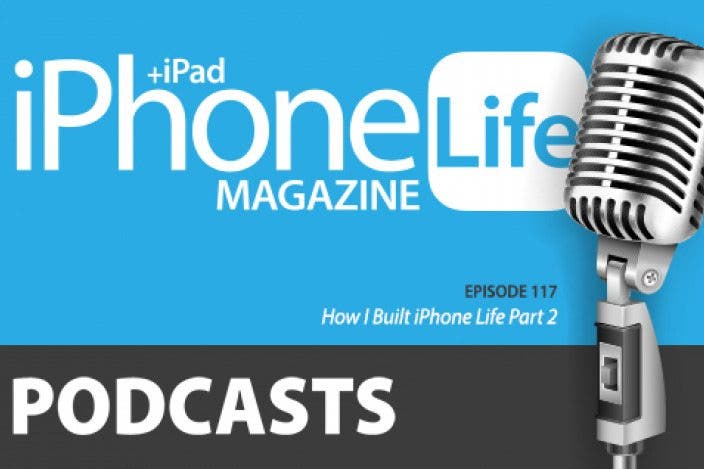
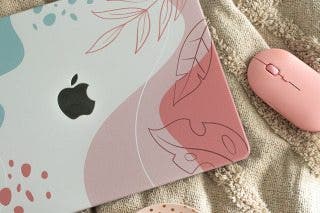
 Leanne Hays
Leanne Hays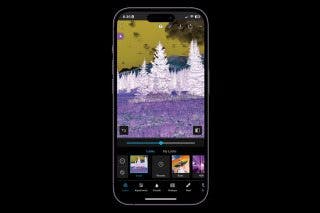
 Rachel Needell
Rachel Needell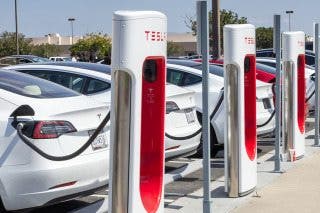
 Olena Kagui
Olena Kagui Rhett Intriago
Rhett Intriago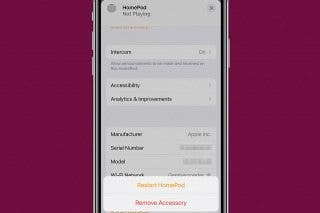
 Amy Spitzfaden Both
Amy Spitzfaden Both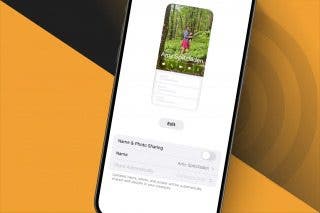

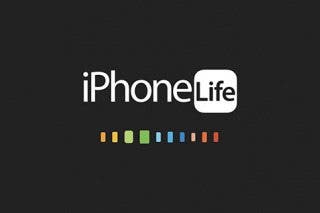
 Susan Misuraca
Susan Misuraca